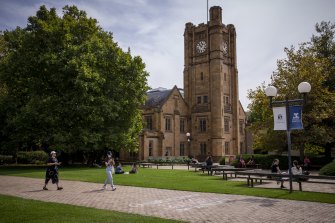The University of Melbourne has posted a bumper surplus of $147 million for 2021, its best result in five years, but says it expects to fall into the red this year, partly due to a drop in student revenue compared with pre-pandemic times.
The university’s healthy surplus last year was revealed on Tuesday and followed a two-year “pandemic reset program” in which 378 staff either took redundancy or were made involuntarily redundant.
The University of Melbourne has posted a $147 million surplus for 2021.Credit:Wayne Taylor
It is consistent with a financial turnaround that the Victorian university sector enjoyed last year compared with the losses several incurred in 2020, when Australia’s border was shut to international students. The closure led to thousands of job losses and sweeping subject cuts as universities tightened their belts in response to being denied access to the $89 billion JobKeeper scheme.
University of Melbourne vice chancellor Duncan Maskell said it had stabilised itself in terms of the effects of the pandemic but still faced challenges.
“We expect that revenue will be down $1.4 billion between 2020-2024 compared to pre-pandemic estimates, and we anticipate a large operating deficit for 2022,” he said.
“This expected downturn will be helped by the strong 2021 financial result, but the university must continue its careful and prudent approach to financial management.”
The university, which posted a modest $9 million surplus in 2020, said last year’s better operating result would not have been achieved without an “unexpected” $111 million grant it received from the federal government and a $254 million reduction in spending.
Those savings included a freeze on non-essential hiring and a pause on international travel by staff, cuts in the use of casual labour, and savings on campus operations during Melbourne’s extended lockdowns.
Meanwhile, new research from Australian National University reveals many domestic university students actually did better financially during the pandemic than if COVID-19 had never reached Australia.
International students, on the other hand, suffered longer financial hardship. Overseas students lost their jobs in large numbers at the beginning of the pandemic, but unlike domestic students received no JobKeeper support.
For domestic students, JobKeeper “often paid more than their wages”, a report by Andrew Norton, ANU professor in the practice of higher education policy, states.
The end of lockdowns late last year also triggered a jobs boom for domestic and international tertiary students, the report found, with a record 72.5 per cent of students aged 24 or under employed in December last year. This was up from 65 per cent in December 2019, before the pandemic.
But Dr Norton warned in his report that the favourable jobs market for tertiary students was unlikely to last.
“Temporary migrants will return to Australia and tighter macroeconomic policy will reduce demand for labour,” he wrote.
“But in the short term, at least, tertiary student finances should remain better than before COVID-19.”
Tertiary students are taking up jobs in large numbers as drivers and store workers, reflecting the shift from retail shopping and cafe and restaurant dining to online ordering and home delivery, and as health workers in fields such as vaccination work.
The Morning Edition newsletter is our guide to the day’s most important and interesting stories, analysis and insights. Sign up here.
Most Viewed in National
From our partners
Source: Read Full Article


